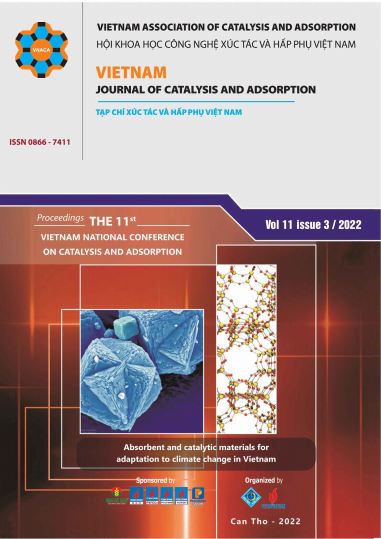Treatment of wastewater from the flocculation process of waste cutting fluid by zerovalent iron catalyst
DOI:
https://doi.org/10.51316/jca.2022.057Keywords:
Waste cutting fluid, iron catalyst, wastewater treatmentAbstract
Waste cutting fluids are considered as hazardous wastes because they contain numerous different components causing environmental problems. Normally, a flocculation method is applied to treat preliminarily. However, the output wastewater still needs treating further to meet the national standards of industrial wastewater before disposal. So, this research reports the secondary treatment stage of the waste cutting fluid collected from an industrial factory in Vietnam using zero valent iron (ZVI) catalyst. This catalyst was synthesized via a redox reaction between sodium borohydride (NaBH4) and ferric chloride (FeCl3). Key factors affecting the quality of the ZVI particles such as the concentration of the NaBH4 reductant, reaction temperature, and dropping rate were investigated systematically. At the optimum synthesis conditions, viz. the NaBH4 concentration of 0.2 M, reaction temperature of 25 oC and the dropping rate of 3 ml/min, the synthesized ZVI exhibited a narrow range of particle size distribution with a mean size of 3.9 μm, followed by a high surface area, and good catalytic activity. As a catalyst for secondary treatment of the waste cutting fluid, the synthesized ZVI demonstrated a moderate chemical oxygen demand (COD) removal performance of 49%, corresponding to COD reduction for from 4023 mg/l to about 2059 mg/l.
Downloads
References
Sánchez-Oneto, J.R. Portela, E. Nebot, E. Martínez de la Ossa. J. Hazard. Mater, 2007, 144, 639-644. https://doi.org/10.1016/j.jhazmat.2007.01.088
P. Rajasulochana, V. Preethy. Resource-Efficient Technologies, 2016, 2, 175-184. https://doi.org/10.1016/j.reffit.2016.09.004
S. Ma, K. Kim, J. Huh, D.E. Kim, S. Lee, Y. Hong. Sep. Purif. Technol., 2018, 199, 289-297. https:// doi.org/10.1016/J.SEPPUR.2018.02.005
C.T. Hai Nam, N.T. Thu Hien, N.T. Thu Huyen, H.H. Hiep, N.T. Thuong. Journal of Chemistry, 2021, 2021, 7248402.
https://doi.org/doi.org/10.1155/2021/7248402
QCVN 40:2011/BTNMT National Technical Regulation on Industrial Wastewater. Minister of Natural Resources and Environment, 2011.
T.A. Aragaw, F.M. Bogale, B.A. Aragaw. J. Saudi Chem. Soc., 2021, 25, 101280. https://doi.org/10.1016/j.jscs.2021.101280
H. Wu, W. Wei, C. Xu, Y. Meng, W. Bai, W. Yang, A. Lin. Ecotoxicol. Environ. Saf, 2020, 188, 109902. https://doi.org/10.1016/j.ecoenv.2019.109902
Y. Hu, X. Peng, Z. Ai, F. Jia, L. Zhang. Environ. Sci. Technol., 2019, 53, 8333-8341. https://doi.org/10.1021/acs.est.9b01999
X. He, X. Min, T. Peng, F. Zhao, Y. Ke, Y. Wang, G. Jiang, Q. Xu, J. Wang. J. Chem. Eng. Data, 2020, 65, 1936-1945.
https://pubs.acs.org/doi/10.1021/acs.jced.9b01110?goto=supporting-info
M. Liu, Y. Wang, L. Chen, Y. Zhang, Z. Lin. ACS Appl. Mater. Interfaces, 2015, 7, 7961-7969. https://doi.org/doi.org/10.1021/am509184e
L. Liang, X. Guan, Z. Shi, J. Li, Y. Wu, P.G. Tratnyek. Environ. Sci. Technol., 2014, 48, 6326-6334. https://doi.org/doi.org/10.1021/es500958b
H. Yu, T. Zhang, Z. Jing, J. Xu, F. Qiu, D. Yang, L. Yu. Chem. Eng. Sci., 2019, 205, 278-286. https://doi.org/10.1016/j.ces.2019.05.012
J.C. Koenig, H.K. Boparai, M.J. Lee, D.M. O’Carroll, R.J. Barnes, M.J. Manefield. J. Hazard. Mater., 2016, 308, 106-112. https://doi.org/10.1016/j.envint.2019.01.030
F. He, Z. Li, S. Shi, W. Xu, H. Sheng, Y. Gu, Y. Jiang, B. Xi, Environ. Sci. Technol., 2018, 52, 8627-8637. https://doi.org/10.1021/acs.est.8b01735
C. Tan, Y. Dong, D. Fu, N. Gao, J. Ma, X. Liu. Chem. Eng. J., 2018, 334,1006-1015. https://doi.org/10.1016/j.cej.2017.10.020
S. Rodriguez, L. Vasquez, A. Romero, A. Santos. Ind. Eng. Chem. Res., 2014, 53,12288-12294. https://doi.org/10.1021/ie501632e
O. Eljamal, R. Mokete, N. Matsunaga, Y. Sugihara. Chem. Eng., 2018, 6, 6207-6220. https://doi.org/10.1016/j.jece.2018.09.012
Y.-Y. Zhang, H. Jiang, Y. Zhang, J.-F. Xie. Chem. Eng. J., 2013, 229, 412-419. https://doi.org/10.1016/j.cej.2013.06.031
C.K. Remucal, C. Lee, D.L. Sedlak. Environ. Sci. Technol., 2011, 45, 3177-3178. https://doi.org/10.1021/es102401d
Downloads
Published
Issue
Section
How to Cite
Share
Funding data
-
Trường Đại học Bách Khoa Hà Nội
Grant numbers T2020-SAHEP-030










